| The Callington
Branch Locomotives |
|||||||
|
|||||||
This page describes the various locomotives used on the former Callington Branch railway line. Please click here for an Index of all Callington Branch pages in RailWest.
To be completed.....
The East Cornwall Mineral Railway (ECMR) had two 3' 6" gauge 0-4-0STs, numbered 1 and 2, which were built for it in 1871 by Neilson & Co of Glasgow (works numbers 1660 and 1661). These engines were of typical Neilson appearance with stovepipe chimneys and 'ogee' style saddle-tanks, and were built to the following dimensions:-
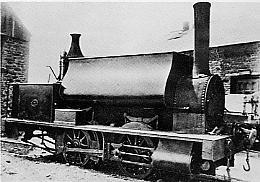 |
|
As far as is known the ECMR livery was plain black, with red buffer-beams and wheels. In common with the rest of the ECMR rolling-stock the Neilson engines had centre buffer-couplers and also side-chains. In due course these locomotives passed with the line into the ownership of the Plymouth, Devonport & South Western Junction Railway (PD&SWJR) and continued working under the new regime without alteration.
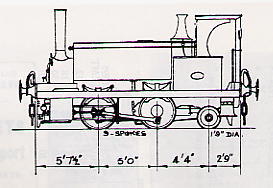 With the conversion of the line to standard gauge the
fate of both of these locomotives is not entirely clear. No 2 was re-gauged to 4'
8½" in the works at Callington and converted to a 0-4-2ST, with a new cab and vacuum
brakes being added. Some sources say that No 1 was converted also (although possibly
without the addition of vacuum brakes), only to be sold in 1909. Another source says that
it was taken out of service in 1907 and then either scrapped or possibly sold later in
1912 without having been converted. In July 1912 ex-ECMR No 2 was sold to Colonel
Stephens for £250 and he transferred it to the Selsey Tramway line, where it was re-built
yet again and gave useful service under the new name of 'Hesperus' until it was withdrawn
and scrapped in 1927.
With the conversion of the line to standard gauge the
fate of both of these locomotives is not entirely clear. No 2 was re-gauged to 4'
8½" in the works at Callington and converted to a 0-4-2ST, with a new cab and vacuum
brakes being added. Some sources say that No 1 was converted also (although possibly
without the addition of vacuum brakes), only to be sold in 1909. Another source says that
it was taken out of service in 1907 and then either scrapped or possibly sold later in
1912 without having been converted. In July 1912 ex-ECMR No 2 was sold to Colonel
Stephens for £250 and he transferred it to the Selsey Tramway line, where it was re-built
yet again and gave useful service under the new name of 'Hesperus' until it was withdrawn
and scrapped in 1927.
PD&SWJR - Hawthorn Leslie locos
In 1907 Colonel Stephens turned to the builders Hawthorn Leslie of Newcastle-upon-Tyne for locomotives for the new Light Railway and he ordered from them two big 0-6-2Ts to cater for the heavy gradients and sharp curves. These engines were built as works numbers 2695 and 2696, and were named by the PD&SWJR as Lord St Leven and Earl of Mount Edgcumbe after two of the Company's directors. These locomotives proved to be very succesful - the 6-coupled wheels provided adequate adhesion on the challenging gradients of the line, while the flexibility of the trailing truck proved essential on the sinuous curves that were the legacy of a former narrow-gauge mineral line. Unusually for a UK industrial locomotive at that time a Belpaire firebox was provided, but there was some similarity with work done at about the same time for overseas railways.
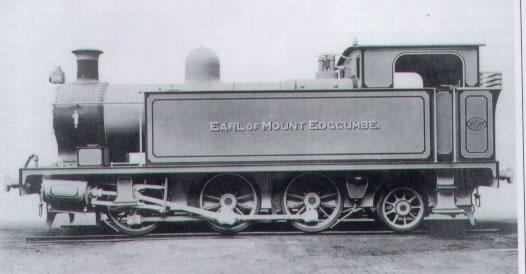
"Earl of Mount Edgcumbe" in
works grey livery
The original livery for these locomotives was dark blue (with black and red lining?) with copper cap chimney, dome covers and safety valve bases (a favourite scheme of Colonel Stephens), but after about 1912 it was changed to a dark green with red and white lining. Under the PD&SWJR the engines ran without numbers, but when taken into London & South Western Railway (L&SWR) stock on 11-Dec-1922 they became Nos 758 and 757 and continued with those numbers under Southern Railway ownership. After British Railways was formed in 1948 they became 30758 and 30757. On the Callington Branch these engines were used mainly on goods services, but did appear on passenger trains also on many occasions. The arrival of Ivatt 2-6-2Ts in September 1952 made them redundant on the Callington Branch, but they continued to work intermittently in the Plymouth area until moving to Eastleigh in mid-1956. Lord St Leven hardly worked again, but Earl of Mount Edgcumbe acted as shed and works pilot until it was withdrawn at the end of 1957. For a brief period in August 1926 Lord St Leven took part in trials on the newly-opened North Devon & Cornwall Junction Light Railway from Torrington to Halwill Junction - another railway in which Colonel Stephens had been involved.
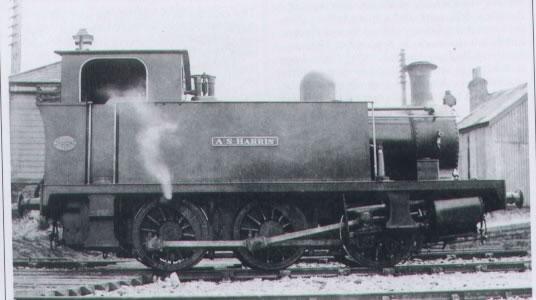
"A S Harris" seen at Bere
Alston in PD&SWJR days
Colonel Stephens also purchased a third locomotive from Hawthorn Leslie, this time one of their standard 0-6-0Ts with 16" cylinders. This engine was named A S Harris after another PD&SWJR director and supposedly it was ordered for use on passenger trains, although it is unclear why Stephens made this distinction or thought that it would be more suitable for that task. In practice the 0-6-2Ts appeared quite frequently in passenger service whilst A S Harris acted as shunter at Callington. A S Harris became L&SWR No 756 on 11-Dec-1922, although it did not get to carry that number until after some after it had passed to the Southern Railway in the following year. The SR eventually replaced it on the branch in June 1929 with an 02 class 0-4-4T. Thereafter the locomotive was tried on the Wenford Bridge mineral branch and at various times shunted at Winchester, Eastleigh, Stewarts Lane, Fratton, Bournemouth, Brighton, Tonbridge, Folkestone and Dover, with a lengthy stay as Nine Elms shed pilot from 1931 to 1939. Finally in August 1951 it was condemned at Stewarts Lane with firebox problems.
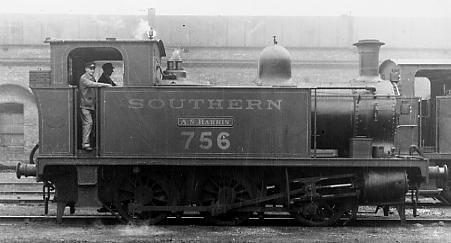
"A S Harris" in Southern
Railway days
To be continued...
© Chris Osment 2002
Hawthorn Leslie locomotives PD&SWJR photographs courtesy The Colonel Stephens Museum